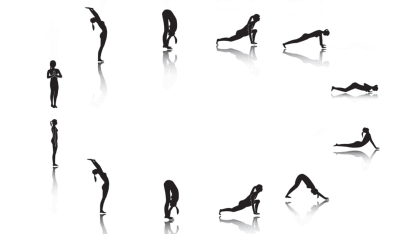Howdy Scarlet Caps! Today I want to discuss sequencing of yoga poses. Not knowing what to do, in what order, is one of the most common reasons people tell me they do not practice yoga at home.
If you've ever taken a yoga class, you may have heard the instructor talk about the order of what you're doing. In fact, it is commonly accepted that certain poses follow others in yoga. The Sun Salutation sequence is the classic example of this: they are a series of 12 poses done in a particular order.
Yoga Sequencing

By
Scarlet Caps @scarletcaps
Other commonly taught "rules" are that forward folds should follow back bends, and fish pose should follow shoulder stand.
The truth is, different yoga styles have their own ideas about sequencing. One style may put headstand toward the beginning of the class and another toward the end, for example.
Following traditional rules on sequencing makes a lot of sense when first starting a yoga practice. Above all, you want to be safe and learning the rules can teach you fundamental principles of alignment that will help keep you there. And having a sense of structure can help you learn a new skill more easily.
For years, this is how I practiced yoga: I followed the rules, no questions asked. Then one day something interesting happened. I had just finished a long run at the gym and wanted to cool down and stretch out a little. I was in the mood to listen to some music and all that was handy was a Sarah McLachlan CD (remember those?). So I put it on, got down on the floor and my yoga has never been the same.
Instead of following the rules just for the sake of doing that, I found myself moving with the mood and rhythm of the music. And it felt so much better than following someone else's script because it was more natural and more in tune with what my body, and mind, needed me to do. So instead of doing fish pose after shoulder stand, which never felt good to me, I pulled my knees into my chest and stayed there for a few breaths. It felt great...and transformational.
There are purists who will disagree strongly with this point of view and that's fine. I don't presume that what works for me will work for you. But consider that yoga isn't modeling or an adult version of Simon Says. The whole point is to find your center, to follow your breath, to stay present in the moment as you experience it.
So if you're one of those people who would like to do some yoga at home, or in a corner of the gym after your workout but get stuck thinking, What should I do next? Here are some tips to help you get started:
Start with some gentle stretching to warm up. If you practice in the morning, like I do, you should be prepared to be a bit stiff and tight so take it slowly. Try not to think about what you're doing… feel what you're doing. Focus on being still. It may help to close your eyes, let your breath be deep and full, and see if you can sense and then follow your intuition. Don't worry about the order of your movements, just do what comes naturally.
And then keep going.
This means that if your entire yoga practice is lying or sitting on the floor, that's fine. There have been sessions with the Caps where we don't stand up at all. The main thing is to respect where you're at physically and mentally, not to do sun salutations, or corpse pose or fill in the blank pose because that's what you think you're supposed to do.
My yoga teacher, Erich Schiffmann, once said that learning yoga is like learning how to play a musical instrument. First you learn the notes and scales, then a few simple songs, then more difficult songs...all written by someone else. But to become a true musician, you start to write your own music and play to your own beat.
Like Sarah McLachlan.


















